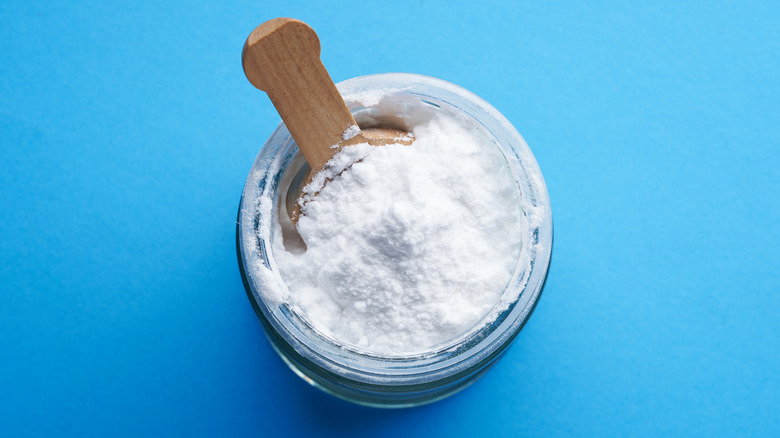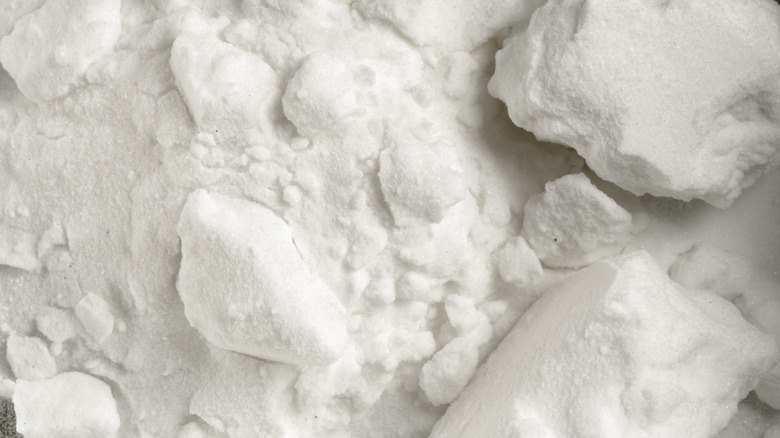Why You Should Start Baking Your Baking Soda
You probably have baking soda in your pantry, but odds are, you aren't getting as much out of it as you could be. Truth be told, baking only accounts for a tiny fraction of sodium bicarbonate's many uses. It is useful in all kinds of other cooking projects; for example, the technique of velveting, often used in Chinese cuisine, entails using baking soda to tenderize meat. You may also know baking soda as a household cleaner, particularly useful for tasks like removing labels from glassware. Yet even these uses only scratch the surface of what baking soda can do. This everyday ingredient is hiding a secret identity that you can unlock with a little help from your oven.
By introducing baking soda to the heat of an oven, you can transform it from sodium bicarbonate into a different chemical called sodium carbonate, also known as soda ash. They are closely related, as their names suggest, but a subtle difference in their chemical formulas gives them different properties in the kitchen. Unlike baking soda, sodium carbonate is not used as a leavening agent in baking. It is primarily used for flavor, tenderizing, and bringing toothsome texture to breads and noodles. Baked baking soda is the key to the best pretzels, stir fries, and ramen noodles of your life, and it couldn't be easier to make.
What happens when you bake baking soda
To convert sodium bicarbonate into sodium carbonate, start by spreading an even layer of baking soda onto a rimmed baking sheet. Then, pop it into an oven set to 250 to 350 degrees. As the baking soda bakes, it will let off water vapor and carbon dioxide, which will reduce the overall weight of the soda by about a third. The amount of time this takes can vary significantly from oven to oven: It could take 1 hour or it could take 5. To check on the progress of your baking soda, weigh it before you put it in the oven. (First, weigh the empty baking sheet, then weigh it with the baking soda. The difference between the two numbers is the weight of the soda.) Check on it every half hour, and once a third of the weight is lost, the conversion is complete.
All of the water and carbon dioxide that evaporates from the baking soda as you bake it triggers a chemical reaction. The loss of hydrogen, oxygen, and carbon atoms changes sodium bicarbonate into sodium carbonate, which in turn causes a dramatic change in pH levels. Sodium bicarbonate is a mild base, with a pH of 8.3, but sodium carbonate is a strong base, with a pH of 11.3. To put it in other terms, sodium carbonate is 1,000 times more basic than baking soda. That makes a world of difference in the kitchen.
What to make using sodium carbonate
We use a lot of acids in our cooking, like vinegar, citrus, and wine. People even use sour milk to make bread. But when it comes to the other end of the pH scale, the options are much scarcer. Baking soda is the only base most home cooks use on a regular basis, but baking it adds another to your arsenal. Sodium carbonate's chemical properties give it unique powers in the kitchen. It is perhaps most popular in Chinese and Japanese cuisine, where it is used to give noodles a springy texture. This works because sodium carbonate tightens gluten networks, creating the signature chewy texture of traditional ramen noodles. In Chinese cuisine, sodium bicarbonate is also added to fermented bread dough to balance its acidity.
Sodium carbonate is also a popular substitute for lye in cooking. Lye is most associated with German-style soft pretzels, giving them their characteristic flavor and deep brown color. Unfortunately, lye is quite caustic; it can be dangerous to work with and difficult to find in stores. Many pretzel recipes swap lye for baking soda, but the results aren't the same. Using sodium carbonate will get you much closer to the flavor and texture of lye-dipped pretzels, without the same risks. However, you should still wear gloves when handling baked baking soda because it can irritate your skin.


